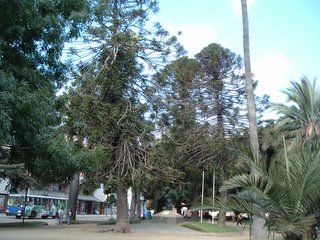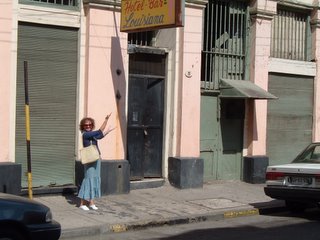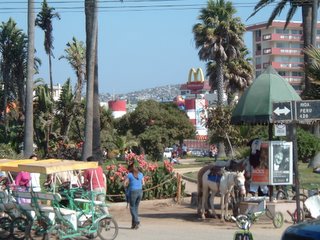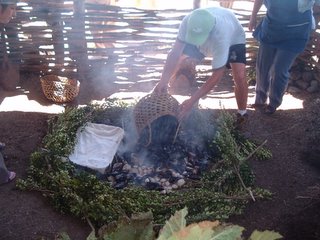
Remember that roadtrip to Chaiguao that got diverted to Auchac a couple days ago because of the lack of transportation to Chaiguao? Well, today I got up early and got to the bus station at 8am to catch the morning bus to Chaiguao (there are buses at 8am, 1:30pm, and 6pm). The bus was pretty full (about 20 people in the little bus) and we bounced along a dusty gravel road right from the outskirts of Quellón. The ride is only 12 kilometers (about 7 miles maybe) and took about 35 minutes. Slow going.

After dropping off and picking up people along the way we were down to just 4 or 5 of us on the bus when it crossed a long bridge and stopped. The driver turned to me and said, "Chaiguao". Funny how these drivers always remember where the gringo is going...
I hopped off the bus in hopes of finding a cafe or
tienda or something to get some water (the bottle I bought at the station was down to just 2 inches of water after drinking most of it on the trip) and maybe something to eat. The first impression wasn't promising as you can see from the photo... No town. No village. No cafe. No
tienda. As they say in Spanish,
no hay nada. There's nothing. Just a Y in the road at the end of a bridge and a couple deserted schoolhouses.
A sign at the Y said the beach was to the right (200 meters) and some village named Chilcola was on the left hand road - 3 kilometers away. So I took the road to the right toward the beach.
Things didn't get better. A cafe materialized, but it looked like it hadn't had a paying guest during my lifetime. There were also some rundown cabins for rent with no evidence of recent

habitation. I followed the narrow one lane dusty road and eventually hit the beach.
Well, "beach" might give you the impression that I mean something like those pictures of the beach at Viña del Mar from the early days of this trip. This was definitely not a beach like that. The tide was out and the beach was covered with rotting seaweed and other odiferous items of both known and unknown origin. There were no
chicas in bikinis. Out in the bay were massive salmon rearing pens (farmed salmon is a HUGE

business here in Chile). Along the shore were houses that people who tend the salmon farms live in.
No, "houses" is the wrong word. Hovels might be closer. Or rundown shacks. The word " house" gives you the wrong impression. No electricity. No water. No plumbing.
No hay nada. As I walked along the road that paralleled the beach I got the impression that I had wandered onto the wrong side of town.
Just after taking the lefthand turn to follow the beach road I saw a bus bouncing down the road towards me (and heading back home to Quellón). I flagged it down and asked if he was going to Quellón - he said he was. For an instant I considered bagging the whole idea and heading back to the comforts of home. But then I thought things might get better, that this is a different bus from the one I took here so maybe there were more options to leave than the 1:30pm bus, and that I had a responsibility to my blog readers to get the story - whatever it is...
So I waved to the driver and said, "no thanks". He closed the door and rumbled off probably wondering what that was all about.

That was a mistake on my part...
I continued up the narrow dusty road with the beach on my right. A few interesting birds caught my attention. One a big hawklike bird. Others were sea birds with long narrow beaks that wandered along the tide eating this and that. When they flew their cries sounded like some sort of European techno music. Cattle watched me from the fields to my left. Dogs and people watched me from their homes to my right. A tiny memorial with a cross...
The morning light off the mountains and volcanos to the east was about as poor as possible for photography. A haze covered everything and made photos into ghostly images of shadowy mountains behind the rundown beachfront. After walking a mile or so and getting to the main channel (and a cluster of the homes with an increasing number of curious and noisy dogs - some of them pretty big...) I decided that I had seen the best of the scenery and should turn back.
I turned back.
The trek back along the beachside road was quiet except for one house with three very large dogs. Their barking brought out the
senora of the
casa and we exchanged good mornings. A couple other people were walking along the road and were friendly. So apparently the neighborhood wasn't as bad as the appearance would suggest.

When I reached the bridge where the bus had dropped me off it was 10am. I looked around and found the
baños -restrooms - (of a sort) and a
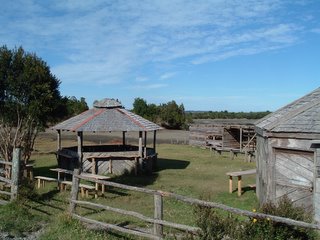
big outdoor
fogón (a barbecue house for
asadas) beside the river. The
fogón was more rustic than the one at Consuelo's mother's apartment - but looked like it could host some authentic cowboy
asadas. Tite later told me that soccer fans have
asados here after games.

The "river" that the bridge crossed turned out to be an estuary of the ocean. It had seemed odd to me that the water apparently was flowing away from the ocean when I arrived (but this is south of the equator and maybe rivers do things like that...), but all was now explained by the rising tide. As the tide came in it filled the lowland north of the bridge and instead of a river it now looked more like a lake. When the tide flowed out, it would empty this lake and it would again look like a river. Depending on the tides the water could be flowing either way under the bridge at a particular time.
I still didn't have a refill on my water and the morning sun was starting to heat up. I also noticed that I had left my hat back at Tite's house (it sits here on the shelf above me as I write...). There was no one around the bridge other than me.
So I waited for either a bus or something that I could hitch a lift.

I waited some more.
A couple cars passed filled with families heading for the beach. It must be their first time out this way... One car heading toward Quellón stopped when he saw my outstretched thumb, but he was only going a short distance to pick up someone. I decided my shady spot at the bridge was probably better than the unknown up the road.
I waited some more.

I took a hike up the other part of the Y in the road to a church on the hill. I took a picture and returned to the Y.
I waited some more.

A truck passed, but didn't give me a lift.
I waited some more.
Some cows came by.
I waited some more.
A
t one point (in just 5 minutes or so) 5 separate bicycles came up from the beach and three went across the bridge and two went up the other road. That was a time of excitement and curiosity for me. But then it passed.

I waited some more.
A huge green bus full of people hanging out of the windows (and a destination of
viaje especial - "special trip"
) came across the bridge. Huge. Like a cross country bus. A Greyhound Bus in the United States. It took the turn to the beach where I had walked and my curiosity turned to amazement. Where could it possibly be going down that direction? That narrow one lane gravel road? Could it ever return? It stopped a short ways away (before getting on the road of destiny) and a few people got out to peer into the windows of the dusty cafe. Then they wandered around and spoke to people in some of the houses around the bridge. Eventually they took over the fogón, hauled boxes and bags out of the bus, and had their own asado.

I waited some more.
The people from the huge green bus wandered around looking at the church, taking pictures (not of the gringo to my knowledge) and looking at the water. They didn't invite the gringo for
asado.
I waited some more.
Eventually, around 1:00 some backpacking teenagers came up from the beach to wait for a bus. So I had company. The two buses came by on their way out from Quellón - one took the left hand route at the Y and the other took the right.
We waited some more.
Finally, around 2:30 (after more than 4 hours waiting at the bridge) the bus on the right hand route (with the driver that I had talked to this morning) came back on his way to Quellón and the backpackers and I piled on. The driver remembered me from this morning (he always remember the odd gringo that stops the bus just to tell him that he doesn't want a ride...).
We bounced along the gravel road back to Quellón...








